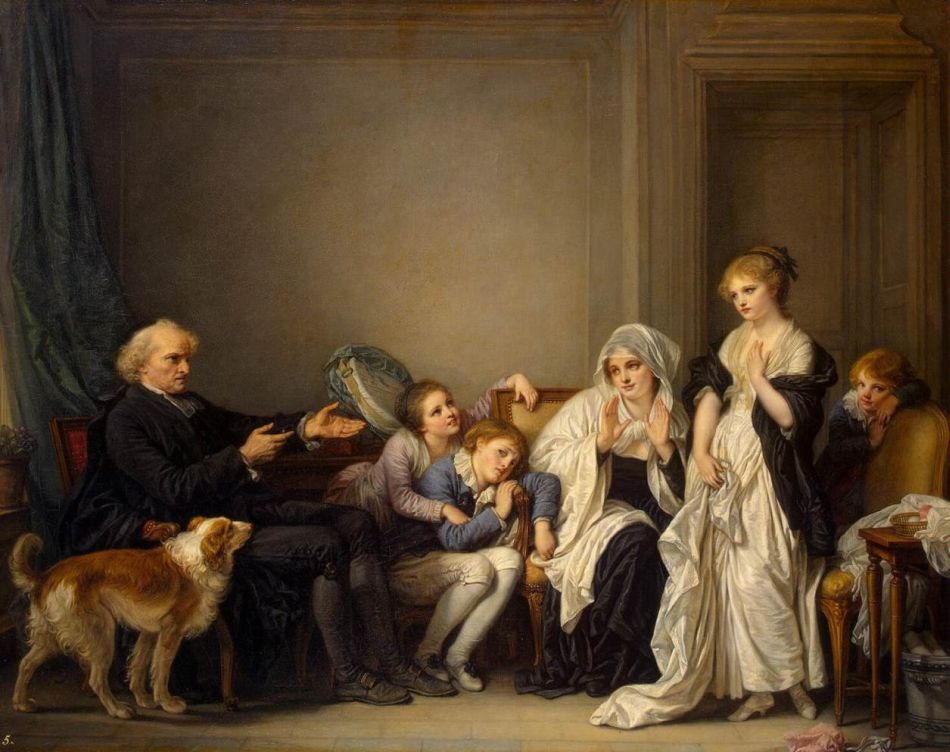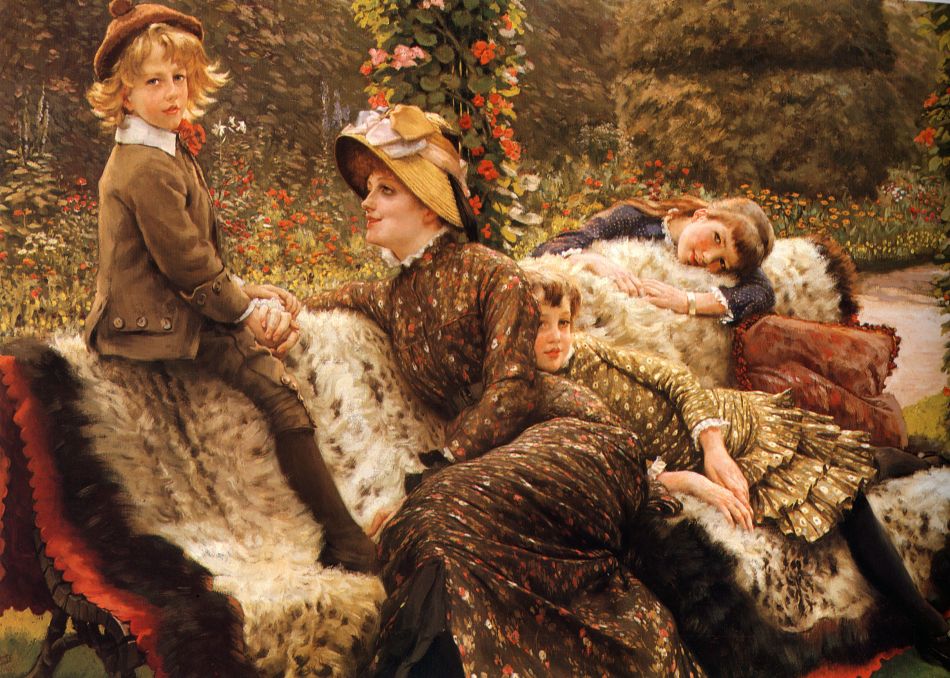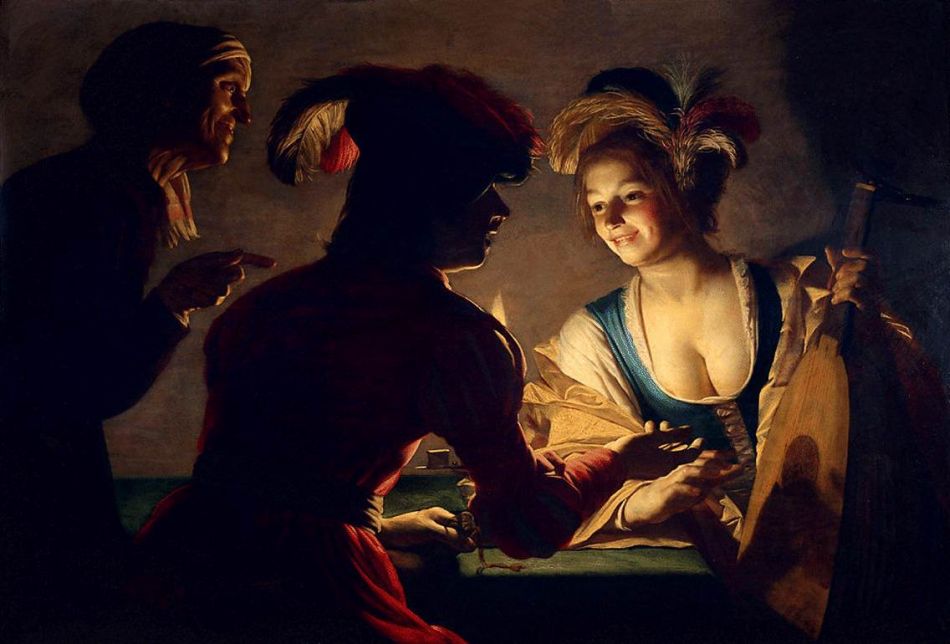DAWN
Daily Arts Web Nucleus
Discover the Arts! Each day a different image from the Literary, Performing, or Visual Arts representing a portion of Scripture plus an explanation with links and a discussion forum 2014 January 30
Image 1: The Widow and Her Priest (1784)
Jean-Baptiste Greuze (1725-1805)
Rococo Style
The Hermitage, St. Petersburg, Russia
Image Credit: Web Gallery of Art
~~~~~~~~~~
Image 2: The Garden Bench - (Divorcee, Kathleen Newton) - (c. 1882)
James Tissot (1836-1902)
Academic and Impressionist Blended Style
Alternate Classification: French Victorian Neoclassical Style
Private Collection
Image Credit: Wikipedia
~~~~~~~~~~
Image 3: The Procuress (1625)
Gerrit van Honthorst (1592-1656)
Dutch Golden Age Baroque Utrecht Caravaggism Style
Centraal Museum, Utrecht, The Netherlands
Image Source: Web Gallery of Art
Explanation: The paintings above depict the three classes of women which the High Priest was not allowed to marry: widows, divorcees, and prostitutes.
Leviticus 21 contains holiness and purity laws for the priests. The first set of regulations concerns funeral practices. The priests were not allowed to defile themselves for any dead Israelite, including relatives -- except for a virgin sister who had no husband. The rule against defilement would preclude touching the body and preparing it for burial. Also, a priest was also not allowed to practice certain mourning rituals such as shaving his head, shaving the corner of his beard, or cutting himself (1-6). They could not marry certain women -- such as whores or divorcees (7-8). If a priest's daughter became a whore she was to be put to death (9). The High Priest, in particular, must not uncover his head for the dead or tear his garments. Nor may he touch a dead body, not even for his father or mother. He must stay in the sanctuary, leaving the funeral to others. He must marry a virgin; and he must not marry a widow, a divorcee, or a harlot; such marriages would profane his seed (10-15). The chapter concludes with certain physical defects which would prevent a man for doing priestly duties. These would include blemishes, particularly if he was blind, was lame, was flat-nosed, had an elongated body feature, was broken footed, was broken handed, was crook backed, was a dwarf, had a blemish in his eye, or had scurvy, had scabs, or had broken stones. Those with such defects were barred from making any of the offerings; but they were allowed to eat those portions of the offerings which belonged to the priests. However, they could not go into the area before the veil (the holy place), or behind the veil (the holy of holies), or come near an altar (16-24).
Leviticus 21
1 And the LORD said unto Moses, Speak unto the priests the sons of Aaron, and say unto them, There shall none be defiled for the dead among his people:
2 But for his kin, that is near unto him, that is, for his mother, and for his father, and for his son, and for his daughter, and for his brother,
3 And for his sister a virgin, that is nigh unto him, which hath had no husband; for her may he be defiled.
4 But he shall not defile himself, being a chief man among his people, to profane himself.
5 They shall not make baldness upon their head, neither shall they shave off the corner of their beard, nor make any cuttings in their flesh.
6 They shall be holy unto their God, and not profane the name of their God: for the offerings of the LORD made by fire, and the bread of their God, they do offer: therefore they shall be holy.
7 They shall not take a wife that is a whore, or profane; neither shall they take a woman put away from her husband: for he is holy unto his God.
8 Thou shalt sanctify him therefore; for he offereth the bread of thy God: he shall be holy unto thee: for I the LORD, which sanctify you, am holy.
9 And the daughter of any priest, if she profane herself by playing the whore, she profaneth her father: she shall be burnt with fire.
10 And he that is the high priest among his brethren, upon whose head the anointing oil was poured, and that is consecrated to put on the garments, shall not uncover his head, nor rend his clothes;
11 Neither shall he go in to any dead body, nor defile himself for his father, or for his mother;
12 Neither shall he go out of the sanctuary, nor profane the sanctuary of his God; for the crown of the anointing oil of his God is upon him: I am the LORD.
13 And he shall take a wife in her virginity.
14 A widow, or a divorced woman, or profane, or an harlot, these shall he not take: but he shall take a virgin of his own people to wife.
15 Neither shall he profane his seed among his people: for I the LORD do sanctify him.
16 And the LORD spake unto Moses, saying,
17 Speak unto Aaron, saying, Whosoever he be of thy seed in their generations that hath any blemish, let him not approach to offer the bread of his God.
18 For whatsoever man he be that hath a blemish, he shall not approach: a blind man, or a lame, or he that hath a flat nose, or any thing superfluous,
19 Or a man that is brokenfooted, or brokenhanded,
20 Or crookbackt, or a dwarf, or that hath a blemish in his eye, or be scurvy, or scabbed, or hath his stones broken;
21 No man that hath a blemish of the seed of Aaron the priest shall come nigh to offer the offerings of the LORD made by fire: he hath a blemish; he shall not come nigh to offer the bread of his God.
22 He shall eat the bread of his God, both of the most holy, and of the holy.
23 Only he shall not go in unto the vail, nor come nigh unto the altar, because he hath a blemish; that he profane not my sanctuaries: for I the LORD do sanctify them.
24 And Moses told it unto Aaron, and to his sons, and unto all the children of Israel.
PARTICIPATION: We have 7 areas available (via email) for your participation. We are accepting contributions for Prose, Poetry, Writers, Visual Artists, Music, DAWN, and ILLUMINATION. DAWN, the page you are presently visiting, features a new image daily and invites discussion of the artist, style, or Biblical subjects depicted. ILLUMINATION features a compact, Illuminated Bible for which we are accepting visual, auditory, musical, and written contributions on any Biblical passage or theme. Our goal is to have a community-made, online, Illuminated Bible.
Please Email Comments, Questions, and Contributions for All Areas To
AD LIB ARTS EMAIL
copyright 2014, Scott Souza
|


